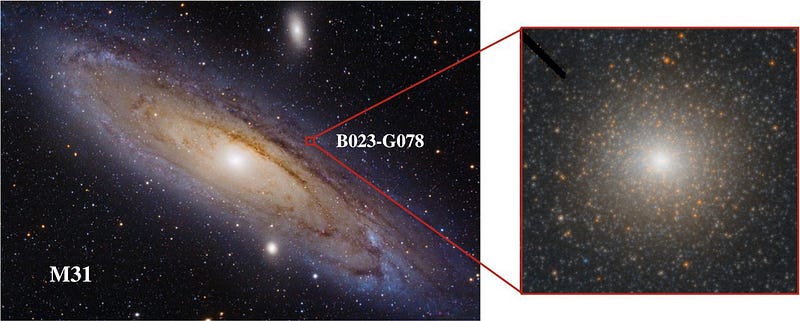Extraordinary Discovery: Intermediate Black Hole Found in Andromeda
Written on
Chapter 1: The Discovery of an Intermediate-Mass Black Hole
Astronomers have made a groundbreaking discovery of a unique black hole with a mass approximately 100,000 times that of the Sun. This black hole is classified as intermediate-mass, making it smaller than the supermassive black holes typically found at the centers of galaxies, yet larger than those formed from the collapse of stars. This finding represents one of the few confirmed instances of intermediate-mass black holes, a category that researchers have been eager to identify.

The newly discovered black hole is nestled within B023-G078, a massive cluster located in our nearest galactic neighbor, the Andromeda Galaxy. Previously thought to be a globular cluster, researchers now assert that B023-G078 is actually a stripped-down core—a remnant of smaller galaxies that have merged into a larger galaxy, losing their outer stars to gravitational forces.
Anil Seth, a professor of astronomy at the University of Utah and the lead author of the study, commented, “We have solid evidence for the existence of both small stellar black holes and supermassive black holes, but the absence of measurements for those in between has been a significant gap in our understanding. This discovery helps to bridge that gap.”
Section 1.1: Understanding Stripped Cores
Stripped cores are the dense remnants of small galaxies that have been absorbed by larger ones. The gravitational forces at play strip away the outer stars, leaving behind a compact core that orbits the larger galaxy, often containing a black hole at its center.
Renuka Pechetti, the lead author of the study and a postdoctoral researcher at Liverpool John Moores University, stated, “While we have identified larger black holes in more massive stripped cores, the existence of smaller black holes within these structures was still unverified until now.”
Subsection 1.1.1: Observations and Measurements
The team utilized observations from the Gemini Observatory and the Hubble Space Telescope to assess the mass distribution within B023-G078. They found that the light profile of this object varied significantly from that of a typical globular cluster.

Unlike globular clusters, which have a consistent light profile, B023-G078 exhibited a rounder center that flattened toward the edges. Additionally, the chemical composition of the stars differed, with those at the core containing more heavy elements compared to those at the periphery.
Section 1.2: The Role of Black Holes
Using their findings, the researchers were able to model the velocities of stars within the cluster. They discovered that stars in the center were moving faster than would be expected without the influence of a black hole.
Pechetti explained, “The velocities we measured provide direct evidence of a central black mass. Forming substantial black holes is exceedingly rare in globular clusters, but if this is indeed a stripped core, then a black hole must already be present, a remnant of the smaller galaxy that merged into a larger one.”
Chapter 2: Implications of the Discovery
Video: New Rare Black Hole Discovered at the Center of Our Galaxy
This video discusses the implications of the recent discovery of an intermediate black hole within the Andromeda Galaxy, expanding our understanding of cosmic structures.
The researchers are optimistic about locating additional stripped cores that may harbor intermediate-mass black holes. Such discoveries could provide insights into the formation of black holes within low-mass galaxies and the processes that shape galaxy evolution.
“We know that larger galaxies typically form through the merging of smaller ones. These stripped-down cores offer a unique opportunity to analyze the interactions that have taken place in the past,” said Seth.
Video: Another Intermediate Black Hole Found Right In the Center of Milky Way
This video explores the findings related to another intermediate black hole and its significance in understanding galactic formation.
This research, conducted by an international team from institutions including the University of Utah, Liverpool John Moores University, and the Harvard-Smithsonian Center for Astrophysics, has been published in the Astrophysical Journal. The article draws upon a press release from the University of Utah.